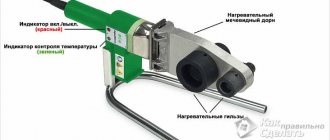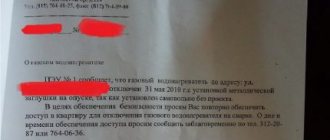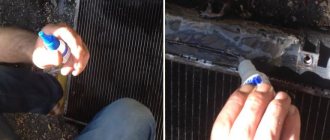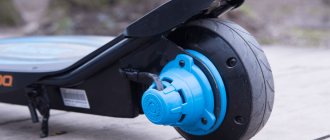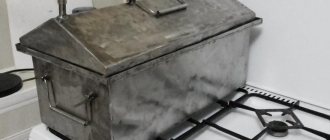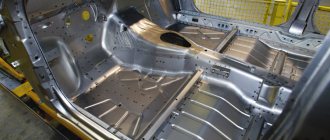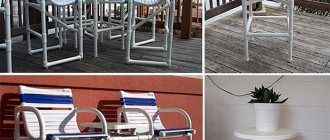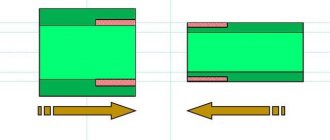How to solder a geyser radiator if the fistula is located in a place accessible for soldering
Before starting soldering, it is necessary to drain the water from the heat exchanger, otherwise the water will remove heat and it will be impossible to warm up the soldering area to the required temperature. To do this, open the hot water tap in the sink or sink and unscrew the union nut from the cold water supply pipe of the geyser. Since the column is located at a level higher than the tap, most of the water will drain, but not all. I use a blower to remove residue. This can be done with a compressor, a vacuum cleaner or your mouth. When blowing with your mouth, you can use a flexible hose from a shower head. One of the union nuts of the flexible hose is screwed through the gasket onto the thread of the water supply tube of the heat exchanger, and through the second end of the flexible hose the heat exchanger tube is blown through the mouth. The remaining water is drained through the tap, and you can begin repairing the heat exchanger.
The soldering itself is not difficult. If you do not have experience with a soldering iron, you can familiarize yourself with the soldering technology on the website page “How to solder with a soldering iron.” Using fine sandpaper, clean the location of the fistula from oxides. As a rule, in this place the copper oxidizes and a greenish stain forms (clearly visible in the photo above). After cleaning, wipe the area with a cloth soaked in solvent to remove grease and dust. Tin with any solder, for example POS-61, (melting point not lower than 180°C) with a soldering iron with a power of at least 100 W.
Rosin can be used as a flux; the kind that is used to rub violin bows is also suitable. If you don’t have rosin, you can successfully use aspirin tablets (sold in pharmacies in the form of tablets called “acetylsalicylic acid”). It’s a wonderful flux, I use it all the time in cases where it’s impossible to clean. For example, when tinning multi-core wires. You paint the tablet and sprinkle the tinning area with small crumbs, or rub the tablet over the heated surface. If, during tinning, the solder does not spread, but lies in a loose layer, it means that the soldering area is not heated sufficiently. In this case, you can additionally heat it with another 40 W soldering iron, hair dryer or iron, placing it next to the soldering area.
When the solder has evenly covered the required surface with a thin layer, you need to build it up to a thickness of 1-2 mm. The fistula on the heat exchanger has been eliminated and will never appear again.
Now carefully inspect the geyser heat exchanger tube along its entire length. If you find a green spot, it means that in this place there is most likely a microhole that allows water to pass through. You need to clean the tube with fine sandpaper until it shines and see if there is a small black dot. If there is one, then it should definitely be tinned and soldered. Otherwise, in a couple of months you will have to do repairs again.
Preparation for soldering
First of all, you need to remove the casing from the column. This must be done carefully, first disconnecting the wires from the display. In some models of water heaters, for example Neva 4510, the gas and pressure regulators must be removed before doing this. Next, turn on the water and locate the leak. Often it is located on the bend of the heat exchanger pipes near the sheathing. If it is easily accessible, it will be possible to seal the fistula without removing the column. If there is no direct access, and the fistula is located from inside the radiator, you will need to disassemble the column and remove the heat exchanger.
After this, the gas is turned off and water is drained from the column. To do this, open the hot water tap and unscrew the union nut from the cold water inlet. Under the influence of gravity, the water will flow out. Modern dispensers have a special plug for draining water, after opening which the liquid is poured into a substitute container. Remaining moisture is blown out with a compressor or vacuum cleaner. This is important because during soldering the liquid will boil and evaporate, creating pressure and blowing the solder through the fistula.
The last stage of preparation is cleaning and degreasing the leak area. This is done using fine-grained sandpaper. You need to clean it carefully so as not to make a through hole, since the pipes in the heat exchanger can be very thin. After this, the cleaned tube is wiped with any solvent or white spirit to remove any remaining dirt and grease.
Which heat exchanger material is best for a column?
In the production of heaters for modern instantaneous water heaters, copper and stainless steel are used. Aluminum heat exchangers are not used in geysers. Perhaps in the future, based on the qualities of the metal (light weight and relatively low cost), boilers will be manufactured using bimetal.
A clear lack of aluminum, susceptibility to thermal shock and impossibility of use at high pressure in the water supply system.
Today, heat exchangers for gas instantaneous or storage water heaters are made from the following metals:
- Copper heaters are installed in the most expensive and efficient boilers. The advantage of copper: good heat transfer, which ensures high efficiency and a short gap between opening the hot water tap and the supply of hot water. The service life of a copper radiator is slightly lower than that of stainless steel (the average lifespan of speakers with a high-quality heat exchanger is at least 12-15 years). Pros: high heat transfer and efficiency.
- Cons: high cost of the heat exchanger, susceptibility to burnout under high temperatures and corrosion.
Heat exchangers of gas flow boilers are made of copper and stainless steel. Budget, cheap models are also produced with galvanized coils. Before choosing a radiator from the best metal, you should consider exactly how the plate heater is designed and functions:
- water is heated using a flow method;
- heat is released when gas is burned from the main burner located under the heater;
- heated vapors rise upward and are accumulated by the radiator;
- Water circulates inside the heat exchanger tubes;
- the liquid is heated exclusively during the passage of the coil, after which it enters the hot water pipeline.
When choosing a heater, take into account the features of its operation. The decision about what type of heat exchanger to purchase is based on the following aspects:
- water heating speed;
- volume of water in the radiator;
- corrosion resistance;
- price;
- heat exchanger weight.
If you need a cheap and at the same time reliable water heater with low performance, you should pay attention to models with a stainless steel coil. Powerful columns of small dimensions, characterized by a high rate of water heating, are produced with copper heaters. The weight of the coil is 3-4 kg, the total weight of the assembled column is about 6-8 kg.
In cheap boiler models, in the production of copper heat exchangers, metal with a large number of impurities is used, which leads to malfunctions even before the end of the warranty period. Possible breakdowns: burnout of the radiator, corrosion and thinning of the coil tubes.
How does a heat exchanger work?
A heat exchanger, or radiator, is designed to heat water from the burner. The flow flows through the coil tubes, instantly warming up from the burning fuel. Most often the block is steel or copper. How much does the device weigh? Copper device - from 3 to 3.5 kg. The steel apparatus is much heavier, for this reason it has lower efficiency.
Features of steel product:
- Lower cost compared to copper.
- Due to the plasticity of the material, heating does not harm the surface.
- It is resistant to corrosion.
Copper device:
- It has high efficiency and fast heating.
- Products that contain additional impurities are cheaper.
- Corrosion resistance.
- Light weight if it is pure copper.
Trying to reduce the cost of production, manufacturing companies add impurities to copper. Because of this, the radiator heats up unevenly, which leads to burnout of individual parts. Some people coat the surface with heat-resistant paint, but this brings little results. The service life does not exceed 2-3 years.
Copper is more resistant to corrosion than steel. Most manufacturers do not indicate how much copper is used to produce the product, convincing them that the heat exchanger is made of a thick layer.
To extend the life of the device, install water filters. They soften and clean the liquid from impurities that settle on parts in the form of scale.
How much does it cost to replace a gas boiler radiator? If you take into account the purchase of a new device, delivery and installation, it will be cheaper to repair the heat exchanger.
Methods for soldering pipes and types of solders
The essence of the soldering process is to fasten the elements of the structure being equipped by adding a molten fastening substance - solder - between them. After cooling, the connection becomes permanent, the solder firmly fixes the parts.
The temperature at which the solder melts must be lower than the corresponding parameter of the elements being fastened, and the capillary effect allows for uniform placement of solder over the entire contact area of the parts.
Additionally, to improve adhesion (surface adhesion) of elements, you can use fluxes and pre-clean the surfaces.
Soldering copper tubes can be done in two ways:
- At low temperature . The method is suitable for arranging household communications. Either hard solder is used, heated above 450°C, or soft solder - up to 400°C.
- At high temperature . Needed for arranging systems subject to heavy loads. The temperature of the solder used reaches 600-900°C.
Soft solders are wires made of low-melting metals (tin, lead, their alloys; sometimes silver and other elements are added). The diameter of such wire is 2-3 mm.
Brazing alloys are rods characterized by an elevated melting point and the ability to withstand high pressure during system operation.
Self-fluxing solders made of copper and phosphorus with the addition of silver are especially popular. Such substances have improved deformation characteristics, they are quite heat-resistant (up to 200°C), fluid, and do not provoke corrosion of the elements being connected. In addition, such compounds are environmentally friendly. Due to the presence of phosphorus in the composition, the melting point of copper is reduced to 750°C; in addition, this mixture is characterized by the same temperature coefficients of expansion as copper, which means that the structure will not experience overloads at the places where seams are placed.
Peculiarities
Water heaters burning natural or liquefied gas are found in tens and hundreds of thousands of homes throughout Russia. But no matter how reliable and well-thought-out their designs are, they always experience significant load. And sometimes it even takes on a transcendental character. The problems are precisely related to this; deformation of the structure often occurs. Most often, the most loaded unit is broken - the heat exchanger.
What is more profitable - repair or replacement?
If you take into account the cost of a new heat exchanger and the work to replace it, and then compare it with the price of a new column, not forgetting about the costs of its delivery and installation, you can clearly see that such repairs are more profitable than replacing the entire column. On average, a new part costs 3,000-5,000 rubles, and you need to pay about 3,000 rubles for installation. At the same time, you will have to pay 8,000 rubles or more for a new speaker, and then also pay for its connection.
Related article: DIY coffee table decor: style and creativity
How to solder a geyser radiator if the fistula is in a place inaccessible for soldering
If the location of the water leak occurs on the wall of the heat exchanger adjacent to the base of the gas water heater, then repairing the heat exchanger by soldering on site is impossible, and it must be removed from the gas water heater. The designers of NEVA LUX-5013 did their best. To remove the heat exchanger for repairs, you need to disassemble almost the entire gas water heater and, most unpleasantly, disconnect the gas pipe. I didn’t want to mess with gas pipes, as it’s dangerous.
The removal of the heat exchanger for repair was hampered by an umbrella for removing gas combustion products, secured with four aluminum rivets to the base of the gas water heater. I had to drill out these rivets with an electric drill, remove the umbrella, and only then did it become possible to remove the heat exchanger. During assembly, instead of rivets, the umbrella was secured to the base with two M4 screws. If the wall does not interfere, you can secure the umbrella with self-tapping screws.
Next, the repair of the gas water heater was carried out using the technology described above. Over the past two years, I have had to repair the heat exchanger, soldering the fistulas, five times. The last time, water began to leak from the side adjacent to the wall of the heat exchanger, and I decided to buy a new one, which I did. I'm going to repair the old heat exchanger of the geyser, I'll tin and solder the tube along its entire length. Photo of the heat exchanger from the side attached to the base.
When purchasing a heat exchanger for a geyser, I was surprised to find that they gave me not a new one, but an already repaired one. The heat exchanger tube had the same soldering that I did when repairing my old heat exchanger. As a result, out of four available in the store, only one heat exchanger was not soldered. It turns out that the plant ships repaired heat exchangers for spare parts that failed during the warranty period. They seal fistulas in them and sell them again. The heat exchanger has a warranty period of only 1 month. It turns out that in a few months the gas water heater will have to be repaired again!
If you have to buy a heat exchanger for a geyser, carefully inspect it. If soldering is detected, it is better to refuse the purchase. If you replace a heat exchanger in a gas water heater under warranty, make sure that you are not getting a refurbished heat exchanger that was in use, but a new one.
Main types of faults
You can fix a malfunction in a gas water heater by turning to specialists for help or doing it yourself. But still, when working with such equipment, it is necessary to know the safety measures, as well as their strict adherence.
IMPORTANT! Otherwise, independent repair of a gas water heater is fraught with HUMAN SACRIFICES.
List of breakdowns found in geysers:
- The igniter does not light;
- The pilot light goes out;
- There is a pipe leaking in the radiator;
- Water is leaking at the connections.
There are two main reasons why a gas water heater leaks. Failure is determined by elimination. Where exactly the fault is located is indicated by the localization of the liquid. The fact that the gearbox has failed will be indicated by water flowing from below. If condensation appears in the column, the heat exchanger (gas column radiator) is faulty.
The most common breakdowns:
- A reducer or water block is a device that sends a signal to open the gas valve and then to ignite. From the inside, the gearbox looks like a hollow structure, divided in two by a membrane. When water is supplied to the reducer, pressure arises, from which the membrane wears out over time, leading to malfunctions. When liquid drips from the column's safety valve, this means that the membrane is blocking water access, but due to wear, the barrier disappears.
- Another sign of a problem with the membrane is a leaking water unit. Such a breakdown can also be caused by failure of the rod sealing gasket.
At first, during operation, only a few drops of water are released; over time, the flow in the gas water heater becomes more and more intense. Microcracks or corrosion in the radiator appear due to constant exposure to fire. As a result, the copper or steel pipes of the coil burn out. In this case, condensation first accumulates on the internal components and the housing. Leak points are indicated by a change in the color of the copper - it turns green.
First of all, if water is flowing from a gas water heater, you need to check the places to which the pipes are connected. This will prevent leaks due to failure of gaskets and loose threaded connections.
Signs of heat exchanger failure
After you have learned in more detail about the principle of operation of a geyser, you can consider the important points necessary to successfully prevent radiator failure.
So, there are several conditions when it is necessary to repair a faulty heat exchanger of a geyser, since the unit itself begins to automatically turn off:
- The flow of water stops and there is no pressure . In this case, the water regulator releases the pusher, which causes the microswitch to turn off.
- The last element of the electromagnetic circuit, that is, the ionization sensor, ceases to “see” the flame . In this situation, the corresponding signal is not given, which is why the gas path is closed by the magnetic valve.
- Draft ceases to form in the chimney . The electromagnet stops working, the electromagnetic circuit is broken and the fuel supply ceases.
- The overheating sensor stops functioning . This component of the circuit is installed directly on the heat exchanger.
After we have understood the nuances of the operation of the gas water heater and possible problems indicating a breakdown of the radiator, we will talk about how to repair it. But first we need to rule out other faults.
Types of gas burners
In general, despite the wide selection of burners, they all consist of the same set of basic elements:
- devices for fixing and holding gas cylinders;
- nozzles;
- device heads;
- gas supply regulator, which allows you to avoid excessive fuel consumption or insufficient heating of the working surface;
- burner reducer.
In addition, depending on the manufacturer and brand of product, burners may be provided with additional elements, such as tips, adapters and others.
Based on the heating temperature of the working medium, burners are divided into:
- household products (gas combustion temperature reaches 1000-1500°C);
- industrial gas burners (corresponding parameter - 1500-2000°C).
Depending on what gas mixture is used during operation of the device, burners are divided into:
- propane - the most common tools, they can be universal or for special purposes; characterized by the possibility of ignition using piezoelectric elements and saving incoming gas;
- using MAPP gas - their distinctive feature is increased energy of gas combustion while maintaining a soft flame, which prevents damage to the pipe;
- acetylene-oxygen - can be equipped with a disposable gas cylinder or work stationary; are used when working on highways.
Gas soldering irons for copper pipes are used to connect corner structures and closing elements of the pipeline with solder.
How to check for leaks
After soldering the geysers, you need to check the tightness of all pipes.
To do this, they are carefully examined to see even the smallest fistulas - their presence is indicated by small green spots. To avoid re-disassembling the column in the near future, these defects are also cleaned and soldered. After this, you need to connect water to the gas water heater with a soldered heat exchanger and open the tap. Water is supplied slowly and gradually so that it displaces the air from the column. Once the entire heating system has been filled, the tap can be opened to full capacity. In this way, the strength of soldering joints is checked under maximum water pressure. At the same time, the soldered joints are re-inspected for water leaks.
At the very end, the boiler with a gas water heater is turned on to check its performance when in contact with hot water. In this case, the soldered areas can be wiped with a dry cloth to detect the slightest signs of moisture.
Checking the result
After completing the soldering of the heat exchanger of the gas water heater, it is necessary to carefully inspect all the pipes of the heating device. If green spots are visible anywhere, these are most likely small fistulas. These places also need to be cleaned and soldered , so as not to dismantle the column again in the future.
Then water is supplied to the column and the tap is gradually turned on. The water in the system should fill slowly. First, air will come out of the tap at the same time as the water. When the system is full, the tap is opened fully to check the soldering with the highest water pressure. At this time, the soldering area is carefully inspected for leaks.
The last step of the test will be to turn on the column and test it with hot water. Just in case of fire, wipe the soldering area with a paper napkin. If there is the slightest moisture, it will show it.
Finding defects
A visual inspection, even after cleaning the metal with sandpaper, does not always allow one to detect the location of flaws. In such cases, special diagnostics are carried out under pressure. You need to supply a water jet inside the radiator unit using a bendable rubber hose for shower cabins. One edge is connected through a gasket to the channel delivering coolant, and the other is connected to the radiator tube. One of the edges of the tube is deliberately closed using a shut-off valve.
Then the tap feeding the water heater is turned on. At this moment, you need to carefully monitor the surface of the heat exchanger and its tubes. Immediately, all the points where there are fistulas will show water droplets. The rest will remain dry, like a desert. An ordinary marker will help you mark problem areas so as not to forget about them.
Connecting the gas outlet pipe to the geyser hood
To repair the heat exchanger, it is necessary to dismantle the gas exhaust pipe. When installing this pipe in place, it is necessary to ensure the tightness of its connection with the geyser hood.
Even a large gap of up to a centimeter can be easily sealed using asbestos soaked in water. This is a heat-resistant material that is available in sheet form. In water, asbestos disintegrates like cardboard and forms a soft mass that molds well. After drying, asbestos becomes quite hard and dense again. Asbestos can be reused. Soak the extracted pieces of it in water.
Leakage of threaded connections
Sometimes water drips from the gas water heater due to leaking threaded connections. In the places where they are located, manufacturers use American nuts (flare nuts).
To seal them, rubber gaskets are used, which, when exposed to high temperatures, lose their elasticity, become hard and allow water to pass through.
To troubleshoot you will need:
- Turn off the water (there is a special tap on the tube through which cold water is supplied to the column);
- Unscrew the threaded connection with an adjustable wrench (it will be easier to unscrew if the connection is slightly heated);
- Take out the old rubber gasket and carefully inspect the threads.
If the thread is not damaged, then you just need to replace the gasket with a new one and tighten the connection with a wrench. If there are defects on the American thread, the union nut will need to be replaced.
The best option would be modern silicone gaskets. They are more durable than rubber seals and provide better sealing. Instead of one gasket, you can use two in one place of the threaded connection.
Model differences
Please note that different models of geysers may differ significantly in their design - this must be taken into account if you plan to independently repair the water heater.
So, Chinese geysers of the Vector brand are not worth soldering at all. The fact is that the radiators in them are formed from very thin copper tubes, in which new fistulas are formed during the soldering process. Thus, if you have a cheap column, it is best to replace the heat exchanger in it with a new one rather than repair it. From the point of view of reliability and quality, among the best representatives of speakers are Oasis brand products from a German manufacturer. They are equipped with heat exchangers that have a long service life. Since the components for such equipment are quite expensive, repairs will be advisable. Soldering leaks on the heat exchanger of the Oasis column will allow you to use it for a long time.
In the middle price segment there are gas water heaters from the Swedish company Electrolux and domestic Niva. In such products, heat exchangers with anti-corrosion protection are installed, the soldering of which will significantly extend their service life.
Pipeline leak
In some cases, the geyser leaks as a result of the formation of holes in the copper pipes. A thorough inspection of the heat exchanger when the water is turned off will allow you to find the location of the leak. Liquid leaks from large holes, minor damage is detected by rust around it and green spots.
What to do to fix the leak:
- Cold welding. It is important that the welding compound used can withstand high temperatures. Similar information can be found on the packaging of the product. You will need to remove a piece of cold welding from the packaging, knead it with your hands (wearing gloves) until it begins to harden. Then apply the composition to the pipe and smooth it until it hardens completely.
- Soldering holes. You can eliminate the reason why the gas water heater is leaking by soldering the damaged area. It will first need to be cleaned, degreased and coated with flux. Using a powerful soldering iron or torch, it is necessary to cover the damage on the pipe with solder (the solder layer should be approximately 1-2 millimeters thick). It is recommended to solder several holes located close to each other with a piece of copper plate. It is not advisable to solder Chinese inexpensive heat exchangers, since very often they are painted on top. In this case, paint is used by manufacturers to hide the uneven color of low-quality copper (it contains impurities). In this case, the tubes burn out during the soldering process because they are too thin.
- Installing a clamp with a rubber gasket. The simplest way to eliminate a leak without damaging the structure. This measure is especially effective if the tube does not fit tightly to the casing and if there is enough space.
Heat exchanger for a geyser: why do you need a radiator, how to solder it and clean it
One of the main elements of a gas water heater, along with the burner, is the heat exchanger. And therefore, problems with this part can worsen the quality of the speaker or even damage the device.
Repair of a geyser heat exchanger due to scale formation
A clogged heat exchanger is the most common reason why a geyser does not heat water well, which in our systems is not of the best quality.
You should know this! To prevent scale formation, you can only use hot water no higher than 45°C, without diluting it with cold water. To do this, you need to change the mode settings.
It is possible to determine that the heat exchanger needs cleaning only when the column is turned on: due to low water pressure, the unit will immediately turn off or not turn on at all. The further procedure is as follows:
- Disassemble the water heater.
- Turn off the liquid supply and open the hot water faucet.
- Remove the supply tube from the unit and drain about 1 liter of liquid from it, then replace the tube.
- Pour the cleaning liquid with anti-scale inside using a funnel and leave for 2 hours.
- After 1-2 hours, resume the water supply and see what composition comes out of the hose. If necessary, you need to repeat everything.
It is important! To speed up the process, you can use an igniter to heat the composition inside the heat exchanger.
Flushing the heat exchanger
Repairing leaks
A visual inspection allows you to detect leaks. To do this, you need to remove the casing, which is secured with bolts or latches. Before carrying out work, you will need to turn off the water and gas supplies. But if water drips from the gas water heater only during operation, then you need to turn on the water heating for a few seconds.
Once the reason why the column is leaking has been identified, you can begin to fix the problem:
- On average, the membrane lasts from five to eight years. To eliminate the leak, you need to change the gaskets on the rod and replace the worn membrane with a new one (for which you will need to remove the “frog” and disassemble its body).
- Gaskets on threaded and other connections last from two to four years. Replacing all gaskets eliminates the leak. A leaking hose cannot be repaired and must be replaced with a new one. The use of sealants or special silicone compounds significantly improves sealing.
Regular maintenance of the gas water heater, including replacement of all seals, prevents leaks. You can clean up leaks at threaded connections with your own hands.
Troubleshooting problems that appear in the membrane requires understanding the operating principle of the water unit and having the skills to maintain such equipment.
The sequence of actions during repairs depends on the equipment model and manufacturer. The Neva, Ariston, Bosch, Oasis or semi-automatic geyser have their own design features and their own segment, which is most susceptible to failure during operation.
